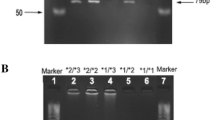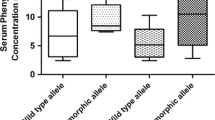Abstract
Purpose
The cytochrome P450 enzyme CYP2C9 metabolizes several important drugs, such as warfarin and oral antidiabetic drugs. The enzyme is polymorphic, and all known alleles, for example, CYP2C9*2 and*3, give decreased activity. Ultra-high activity of the enzyme has not yet been reported.
Methods
We present a patient with Behçet’s disease who required treatment with high doses of phenytoin. When fluconazole, a potent inhibitor of CYP2C9, was added to the treatment regimen, the patient developed ataxia, tremor, fatigue, slurred speech and somnolence, indicating phenytoin intoxication. On suspicion of ultra-high activity of CYP2C9, a phenotyping test for CYP2C9 with losartan was performed.
Results
The patient was shown to have a higher activity of CYP2C9 than any of the 190 healthy Swedish Caucasians used as controls.
Conclusions
Our finding of an ultrarapid metabolism of losartan and phenytoin may apply to other CYP2C9 substrates, where inhibition of CYP2C9 may cause severe adverse drug reactions.


Similar content being viewed by others
References
Bertilsson L, Aberg-Wistedt A, Gustafsson LL, Nordin C (1985) Extremely rapid hydroxylation of debrisoquine: a case report with implication for treatment with nortriptyline and other tricyclic antidepressants. Ther Drug Monit 7:478–480
Bertilsson L, Dahl ML, Sjöqvist F, Aberg-Wistedt A, Humble M, Johansson I, Lundqvist E, Ingelman-Sundberg M (1993) Molecular basis for rational megaprescribing in ultrarapid hydroxylators of debrisoquine. Lancet 341:63
Johansson I, Lundqvist E, Bertilsson L, Dahl ML, Sjöqvist F, Ingelman-Sundberg M (1993) Inherited amplification of an active gene in the cytochrome P450 CYP2D locus as a cause of ultrarapid metabolism of debrisoquine. Proc Natl Acad Sci USA 90:11825–11829
Kawanishi C, Lundgren S, Agren H, Bertilsson L (2004) Increased incidence of CYP2D6 gene duplication in patients with persistent mood disorders: ultrarapid metabolism of antidepressants as a cause of nonresponse. A pilot study. Eur J Clin Pharmacol 59:803–807
Bertilsson L, Dahl ML, Dalén P, Al-Shurbaji A (2002) Molecular genetics of CYP2D6: clinical relevance with focus on psychotropic drugs. Br J Clin Pharmacol 53:111–122
Sim SC, Risinger C, Dahl ML, Aklillu E, Christensen M, Bertilsson L, Ingelman-Sundberg M (2006) A common novel CYP2C19 gene variant causes ultrarapid drug metabolism relevant for the drug response to proton pump inhibitors and antidepressants. Clin Pharmacol Ther 79:103–113
Ohlsson Rosenborg S, Mwinyi J, Andersson M, Baldwin R, Pedersen R, Sim S, Bertilsson L, Ingelman-Sundberg M, Eliasson E (2008) Kinetics of omeprazole and escitalopram in relation to the CYP2C19*17 allele in healthy subjects. Eur J Clin Pharmacol 64:1175–1179
Aithal GP, Day CP, Kesteven PJ, Daly AK (1999) Association of polymorphisms in the cytochrome P450 CYP2C9 with warfarin dose requirement and risk of bleeding complications. Lancet 353:717–719
Kirchheiner J, Brockmöller J (2005) Clinical consequences of cytochrome P450 2C9 polymorphisms. Clin Pharmacol Ther 77:1–16
Patsalos PN, Berry DJ, Bourgeois BF, Cloyd JC, Glauser TA, Johannessen SI, Leppik IE, Tomson T, Perucca E (2008) Antiepileptic drugs—best practice guidelines for therapeutic drug monitoring: a position paper by the subcommission on therapeutic drug monitoring, ILAE Commission on Therapeutic Strategies. Epilepsia 49:1239–1276
Christensen M, Andersson K, Dalén P, Mirghani RA, Muirhead GJ, Nordmark A, Tybring G, Wahlberg A, Yasar U, Bertilsson L (2003) The Karolinska cocktail for phenotyping of five human cytochrome P450 enzymes. Clin Pharmacol Ther 73:517–528
Yasar U, Dahl ML, Christensen M, Eliasson E (2002) Intra-individual variability in urinary losartan oxidation ratio, an in vivo marker of CYP2C9 activity. Br J Clin Pharmacol 54:183–185
de Morais SM, Goldstein JA, Xie HG, Huang SL, Lu YQ, Xia H, Xiao ZS, Ile N, Zhou HH (1995) Genetic analysis of the S-mephenytoin polymorphism in a Chinese population. Clin Pharmacol Ther 58:404–411
Böttiger Y, Laine K, Andersson ML, Korhonen T, Molin B, Ovesjö ML, Tirkkonen T, Rane A, Gustafsson LL, Eiermann B (2009) SFINX-a drug-drug interaction database designed for clinical decision support systems. Eur J Clin Pharmacol 65:627–633
Flockhart D (2007) Drug Interactions: Cytochrome P450 Drug Interaction Table. Indiana University School of Medicine. Available at: http://medicine.iupui.edu/clinpharm/ddis/table.asp. Accessed 15 Feb 2010
Baldwin RM, Ohlsson S, Pedersen RS, Mwinyi J, Ingelman-Sundberg M, Eliasson E, Bertilsson L (2008) Increased omeprazole metabolism in carriers of the CYP2C19*17 allele; a pharmacokinetic study in healthy volunteers. Br J Clin Pharmacol 65:767–774
Kanebratt KP, Diczfalusy U, Bäckström T, Sparve E, Bredberg E, Böttiger Y, Andersson TB, Bertilsson L (2008) Cytochrome P450 induction by rifampicin in healthy subjects: determination using the Karolinska cocktail and the endogenous CYP3A4 marker 4beta-hydroxycholesterol. Clin Pharmacol Ther 84:589–594
Bodin K, Bretillon L, Aden Y, Bertilsson L, Broomé U, Einarsson C, Diczfalusy U (2001) Antiepileptic drugs increase plasma levels of 4beta-hydroxycholesterol in humans: evidence for involvement of cytochrome P450 3A4. J Biol Chem 276:38685–38689
Sahi J, Shord SS, Lindley C, Ferguson S, LeCluyse EL (2009) Regulation of cytochrome P450 2C9 expression in primary cultures of human hepatocytes. J Biochem Mol Toxicol 23:43–58
Mendes D, Correia M, Barbedo M, Vaio T, Mota M, Gonçalves O, Valente J (2009) Behçet's disease—a contemporary review. J Autoimmun 32:178–188
Morgan ET (2009) Impact of infectious and inflammatory disease on cytochrome P450-mediated drug metabolism and pharmacokinetics. Clin Pharmacol Ther 85:434–438
Chaleby K, el-Yazigi A, Atiyeh M (1987) Decreased drug absorption in a patient with Behçet’s syndrome. Clin Chem 33:1679–1681
Tursen U, Tamer L, Api H, Yildirim H, Baz K, Ikizoglu G, Atik U (2007) Cytochrome P450 polymorphisms in patients with Behçet's disease. Int J Dermatol 46:153–156
Ahmad S (1984) Nifedipine–phenytoin interaction. J Am Coll Cardiol 3:1582
Blyden GT, Scavone JM, Greenblatt DJ (1988) Metronidazole impairs clearance of phenytoin but not of alprazolam or lorazepam. J Clin Pharmacol 28:240–245
Shad MU, Preskorn SH (1999) Drug-drug interaction in reverse: possible loss of phenytoin efficacy as a result of fluoxetine discontinuation. J Clin Psychopharmacol 19:471–472
Acknowledgments
This work was supported by grants from the Swedish Research Council, Medicine (3902) and from Karolinska Institutet.
Conflict of interest statement
The authors declare that they have no conflict of interest.
Author information
Authors and Affiliations
Corresponding author
Rights and permissions
About this article
Cite this article
Helldén, A., Bergman, U., Engström Hellgren, K. et al. Fluconazole-induced intoxication with phenytoin in a patient with ultra-high activity of CYP2C9. Eur J Clin Pharmacol 66, 791–795 (2010). https://doi.org/10.1007/s00228-010-0820-7
Received:
Accepted:
Published:
Issue Date:
DOI: https://doi.org/10.1007/s00228-010-0820-7




